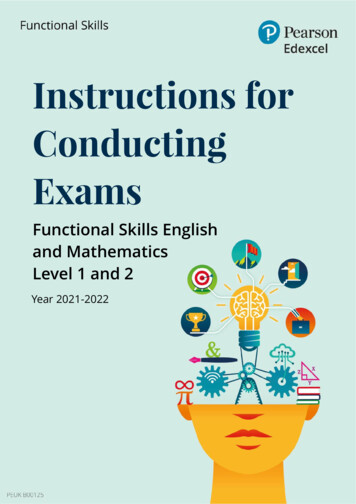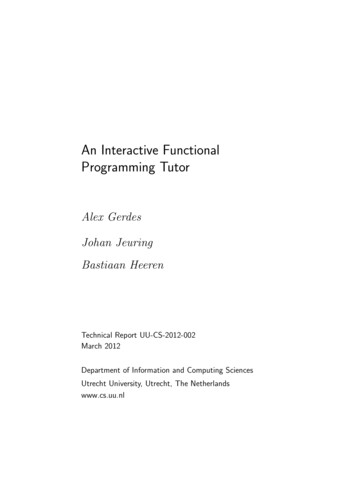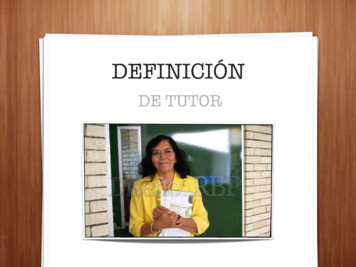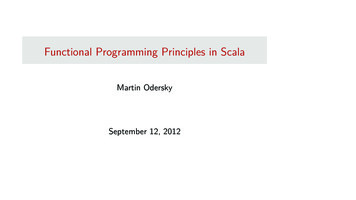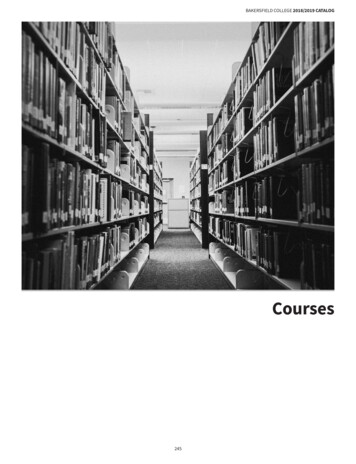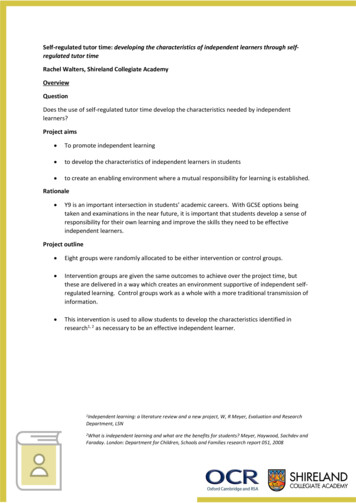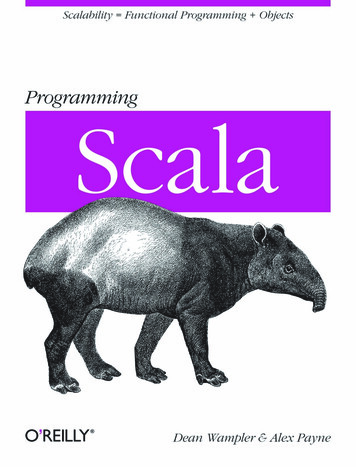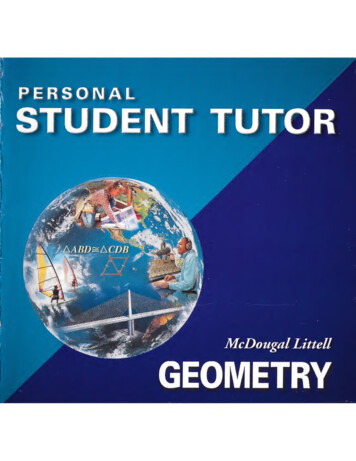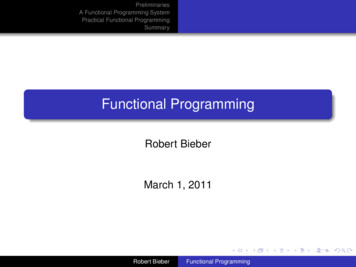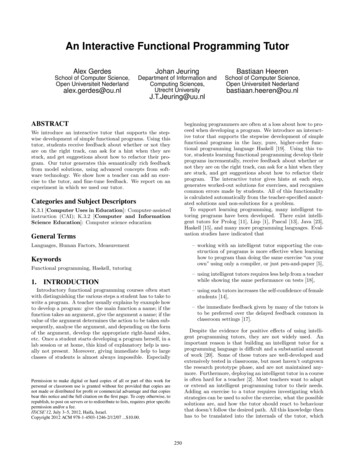
Transcription
An Interactive Functional Programming TutorAlex GerdesJohan JeuringBastiaan HeerenSchool of Computer Science,Open Universiteit NederlandDepartment of Information andComputing Sciences,Utrecht UniversitySchool of Computer Science,Open Universiteit Tbeginning programmers are often at a loss about how to proceed when developing a program. We introduce an interactive tutor that supports the stepwise development of simplefunctional programs in the lazy, pure, higher-order functional programming language Haskell [19]. Using this tutor, students learning functional programming develop theirprograms incrementally, receive feedback about whether ornot they are on the right track, can ask for a hint when theyare stuck, and get suggestions about how to refactor theirprogram. The interactive tutor gives hints at each step,generates worked-out solutions for exercises, and recognisescommon errors made by students. All of this functionalityis calculated automatically from the teacher-specified annotated solutions and non-solutions for a problem.To support learning programming, many intelligent tutoring programs have been developed. There exist intelligent tutors for Prolog [11], Lisp [1], Pascal [13], Java [23],Haskell [15], and many more programming languages. Evaluation studies have indicated thatWe introduce an interactive tutor that supports the stepwise development of simple functional programs. Using thistutor, students receive feedback about whether or not theyare on the right track, can ask for a hint when they arestuck, and get suggestions about how to refactor their program. Our tutor generates this semantically rich feedbackfrom model solutions, using advanced concepts from software technology. We show how a teacher can add an exercise to the tutor, and fine-tune feedback. We report on anexperiment in which we used our tutor.Categories and Subject DescriptorsK.3.1 [Computer Uses in Education]: Computer-assistedinstruction (CAI); K.3.2 [Computer and InformationScience Education]: Computer science educationGeneral TermsLanguages, Human Factors, Measurement– working with an intelligent tutor supporting the construction of programs is more effective when learninghow to program than doing the same exercise “on yourown” using only a compiler, or just pen-and-paper [5],KeywordsFunctional programming, Haskell, tutoring1.bastiaan.heeren@ou.nl– using intelligent tutors requires less help from a teacherwhile showing the same performance on tests [18],INTRODUCTIONIntroductory functional programming courses often startwith distinguishing the various steps a student has to take towrite a program. A teacher usually explains by example howto develop a program: give the main function a name; if thefunction takes an argument, give the argument a name; if thevalue of the argument determines the action to be taken subsequently, analyse the argument, and depending on the formof the argument, develop the appropriate right-hand sides,etc. Once a student starts developing a program herself, in alab session or at home, this kind of explanatory help is usually not present. Moreover, giving immediate help to largeclasses of students is almost always impossible. Especially– using such tutors increases the self-confidence of femalestudents [14],– the immediate feedback given by many of the tutors isto be preferred over the delayed feedback common inclassroom settings [17].Despite the evidence for positive effects of using intelligent programming tutors, they are not widely used. Animportant reason is that building an intelligent tutor for aprogramming language is difficult and a substantial amountof work [20]. Some of these tutors are well-developed andextensively tested in classrooms, but most haven’t outgrownthe research prototype phase, and are not maintained anymore. Furthermore, deploying an intelligent tutor in a courseis often hard for a teacher [2]. Most teachers want to adaptor extend an intelligent programming tutor to their needs.Adding an exercise to a tutor requires investigating whichstrategies can be used to solve the exercise, what the possiblesolutions are, and how the tutor should react to behaviourthat doesn’t follow the desired path. All this knowledge thenhas to be translated into the internals of the tutor, whichPermission to make digital or hard copies of all or part of this work forpersonal or classroom use is granted without fee provided that copies arenot made or distributed for profit or commercial advantage and that copiesbear this notice and the full citation on the first page. To copy otherwise, torepublish, to post on servers or to redistribute to lists, requires prior specificpermission and/or a fee.ITiCSE’12, July 3–5, 2012, Haifa, Israel.Copyright 2012 ACM 978-1-4503-1246-2/12/07 . 10.00.250
The task of a student is to refine the holes, denoted by ,of the program. A student can use such holes to defer therefinement of parts of the program. After each refinement,a student can ask the tutor whether or not the refinement isbringing him or her closer to a correct solution, or, if the student doesn’t know how to proceed, ask the tutor for a hint.Besides holes, a student can also introduce new declarations,function bindings, and alternatives.Suppose the student has no idea where to start and asksthe tutor for help. The tutor offers several ways to help. Forexample, it can list all possible ways to proceed solving anexercise. In this case, the tutor would respond with:implies a substantial amount of work. Other tutors have afixed set of exercises, or enforce a strict order in which aprogram is constructed.Our tutor is built on top of the Helium compiler for Haskell [10], which gives excellent syntax-error and type-errormessages, and reports dependency analysis problems in aclear way. The most interesting feature of our tutor is thatthe hints and feedback given at intermediate steps are derived automatically from teacher-specified annotated solutions and non-solutions for a problem. This reduces the workrequired for using the tutor, and allows a teacher to use herfavourite exercises. Furthermore, the order in which a student constructs a program using our tutor is quite flexible.The tutor is offered as a web application1 , which furtherreduces the burden to use it.This paper describes a tutor that supports the step-wise,flexible development of simple functional programs, givingfeedback and hints at intermediate steps, and showing workedout examples. We make the following contributions:You can proceed in several ways:- Implement range using the unfoldr function.- Use the enumeration function from theprelude3 .- Use the prelude functions take and iterate.We assume a student has some means to obtain information about functions and concepts that are mentioned in thefeedback given by the tutor. This information might be obtained via lectures, an assistant, lecture notes, or even viathe tutor at some later stage. The tutor can make a choicebetween the different possibilities, so if the student doesn’twant to choose, and just wants a single hint, she gets:– The feedback and hints are calculated automaticallyfrom teacher-specified annotated solutions for a problem.– It discusses results of an experiment in which we usedthe tutor in a class-room setting.This paper is organised as follows. Section 2 introducesour interactive functional programming tutor by means ofan example session. Section 3 shows what a teacher has todo to add a programming exercises to the tutor. Section 4discusses the result of using our tutor with a class of beginning functional programming students. Related and futurework is discussed in Section 5, and Section 6 concludes.2.Implement range using the unfoldr function.Here we assume that the teacher has set up the tutor toprefer the solution that uses unfoldr , defined by:unfoldr:: (b Maybe (a, b)) b [a ]unfoldr f b case f b ofJust (a, b 0 ) a : unfoldr f b 0Nothing []AN INTERACTIVE SESSIONThis section introduces our intelligent functional programming tutor by means of some interactions of a hypotheticalstudent with the tutor. We assume that the student hasvisited lectures on how to write simple functional programson lists.The teacher has set a couple of exercises from the Ninetynine Haskell Problems2 , in particular problem 22: Createa list containing all integers within a given range. We nowshow a couple of possible scenarios in which a student interacts with the tutor to solve this problem. At the start of atutoring session the tutor gives a problem description:The higher-order function unfoldr builds a list from a seedvalue, the second argument b. The first argument f isa producer function that takes the seed element and returns Nothing if it is done producing the list, or returnsJust (a, b 0 ), in which case, a is prepended to the output listand b 0 is used as the argument in the recursive call.The student can ask for more detailed information at thispoint, and the tutor responds with increasing detail:Define function range in terms of unfoldr ,which takes two arguments: a seed value, anda function that produces a new value.Write a function that creates a list with allintegers between a given range:with the final bottom-out hint:range :: Int Int [Int ]Define:For example:At this point, the student can refine the function at two positions. In this exercise we do not impose an order on thesequence of refinements. However, the tutor offers a teacherthe possibility to enforce a particular order of refinements.Suppose that the student chooses to first implement the producer function: range 4 9[4, 5, 6, 7, 8, 9]and displays the name of the function to be defined, alongwith its parameters:range x y unfoldr f where f i range x y 12range x y unfoldr 3The prelude is the standard library for Haskell containingmany useful ww.haskell.org/haskellwiki/99 Haskell exercises251
Note that the student has started to define the producerfunction in a where clause. She continues with the introduction of the stop criterion:– list all possible ways in which to proceed,– point out errors, and where the error appears to be,range x y unfoldr f where f i i y 1 – show a complete worked-out example.The next section shows what a teacher has to do to achievethe functionality of the tutor as described in this section.There are several ways in Haskell to implement a condition.Here the student has chosen to define the function f with aso-called guarded expression; the predicate after the verticalbar acts as a guard. The student continues with:3.range x y unfoldr f where f i i y 1 Just The tutor responds with:Unexpected right hand side of f on line 3Here the tutor indicates that the partial definition of f doesnot match any of the model solutions. Correcting the error,the student enters:range x y [x . . y ]range x y unfoldr f where f i i y 1 NothingThe second model solution uses the prelude functions takeand iterate:which is accepted by the tutor. If the student now asks fora hint, the tutor responds with:range x y take (y x 1) (iterate ( 1) x )Introduce a guarded expression that gives theoutput value and the value for the nextiteration.The prelude function iterate returns an infinite list in whichthe next element is calculated by applying a given function,in this case a function that increases its argument by one, tothe previous element, starting with a given value (x ). Thefunction take n returns the first n elements of a list. Thelast model solution uses the higher-order function unfoldrintroduced in Section 2:She continues withrange x y unfoldr f where f i i y 1 Nothing otherwise Just range x y unfoldr f xwhere f i i y 1 Nothing otherwise Just (i, i 1)which is accepted, and thenrange x y unfoldr f where f i i y 1 Nothing otherwise Just (n, i 1)The tutor uses these model solutions to generate feedback.We not only recognise the exact specified model solution, butmany variants. For example, although it appears entirelydifferent, the following solution:which gives:Error:SPECIFYING EXERCISESThe interactions of the tutor are based on model solutionsto programming problems. A model solution is a programthat an expert writes, using good programming practices.A teacher adds a programming exercise to the tutor by specifying such model solutions. For our running example ofcalculating a range, we have specified three model solutions.The first model solution uses the enumeration notation fromHaskell’s prelude:undefined variable nrange x y let f λa if a y 1then Nothingelse Just (a, a 1)g λf x case f x ofJust (r , b) r : g f bNothing [ ]in g f xThis is an error message generated by the compiler. Ourtutor displays the syntax and type errors messages generatedby Helium. The student continues with:range x y unfoldr f xwhere f i i y 1 Nothing otherwise Just (i, i 1)which completes the exercise:is recognised from the third model solution. To achieve this,we not only recognise the usage of a prelude function, suchas unfoldr , but also its definition.We use techniques and concepts from software technology,such as parsing, rewriting, and program transformations, tocalculate semantically rich feedback [9]. In a nutshell, ourapproach is as follows [12]: we derive a programming strategyfrom the set of model solutions. This programming strategyis used to generate many variants of the model solutions.Before we compare a student solution to the solutions fromthe strategy, we normalise all solutions using program transformations. In this normalisation procedure we, for example,rewrite a where-clause into a let-expression.You have correctly solved the exercise.A student can develop a program in any order, as long asall variables are bound. For example, a student can writerange x y where f i and then proceed with defining f . This way, bottom-updeveloping a program is supported to some extent.These interactions show that our tutor can:– give hints about which step to take next, in variouslevels of detail,252
3.1Adapting feedbackcourse after three lectures. 40 students filled out a questionnaire about the tutor, and we collected remarks at the labsession in which the students used the tutor. Table 1 showsthe questions and the average of the answers on a Likertscale from 1 to 5. The first seven questions are related andindicate how satisfied a student is with the tutor. The lastquestion addresses how students value the difficulty of theoffered exercises.The goal of the experiment is to analyse if students appreciate our approach, such as giving feedback on intermediateanswers. The experiment does not check whether or not thetutor is more effective or efficient from a learning point ofview. We hope to study this in the future.It is important that a teacher can easily adapt the feedback given to a student. Our tutor offers the possibilityto fine-tune the generated feedback by means of annotatingmodel solutions. The remainder of this section shows a number of such annotations, accompanied with an explanation.A description of a particular model solution can be addedto the source code using the following construction:{ # DESC Implement range using the unfoldr . # }The first hint in Section 2 gives the descriptions for the threemodel solutions for the range exercise. Next to a descriptionfor a single model solution, we can also give a description ofthe entire exercise. This description is given together withthe model solutions in a configuration file for the exercise.Another way to adapt the feedback is by specifying analternative implementation for a prelude function. For example, the specification below shows how to give an alternative implementation for the iterate prelude function:Reflection on the scores.The scoring shows that the students particularly like theworked-out solution feedback. A worked-out solution presents a complete, step-wise, construction of a program. Furthermore, the kind of exercises are as expected by the students. The results also show that the step-size used by thetutor does not correspond to the intuition of the student.We noticed this already during the experiment. The students often took larger steps than that the tutor was ableto handle.The average of the first seven question gives an overallscore of the tutor of 3,4 out of 5. This is maybe sufficient,but there clearly is room for improvement.{ # ALTiterate f unfoldr (λx Just (x , f x )) # }Using this annotation we not only recognise the preludedefinition (iterate f x x : iterate f (f x )), but also thealternative implementation given here. By adding an alternative a teacher expands the number of accepted solutions and therefore changes the way in which the tutor givesfeedback. Alternatives give the teacher partial control overwhich program variants are allowed.Besides adding alternatives to expand the number of accepted solutions, a teacher may want to emphasise one particular implementation method. For example, a teacher maywant to enforce the use of higher-order functions and prohibit their explicit recursive definitions. The MUSTUSEconstruction allows a teacher to disable the recognition ofthe definition of a prelude function:4.1In addition to questions about the usage of the tutor, thequestionnaire contained a number of general questions, suchas1. We offer the feedback services: strategy hint, step hint,step, all steps, solution, and we check the program submitted by the student. Do you think we should offermore or different feedback services?range x y { # MUSTUSE # } unfoldr f x2. Do you have any other remarks, concerns, or ideasabout our programming tutor?Another way to modify the response of the tutor is to addspecific feedback messages at particular locations in the sourcecode. For example:The answers from the students to the first question indicatethat the current services are adequate. We received someinteresting suggestions on how to improve our tutor in response to the second open question. The remarks that appear most are:range x y { # FEEDBACK Note. # } take (y x 1) iterate ( 1) xThus we give a detailed description of the take function.These feedback messages are organised in a hierarchy basedon the abstract syntax tree of the model solution. Thisenables the teacher to configure the tutor to give feedbackmessages with an increasing level of detail.Adding an exercise to our tutor is relatively easy. To support managing exercises, they can be arranged in classes.Using a class a teacher groups together exercises, for example for practicing list problems, collecting exercises of thesame difficulty, or exercises from a particular textbook.4.Evaluation– Some solutions are not recognised by the tutor– The response of the tutor is sometimes too slowThe first remark may indicate that a student believes herown solution is correct, where in fact this might not be true.It could well be that the program is incorrect or containsimperfections, such as being inefficient, and hence is rejected by our tutor. This remark addresses the fact that wecannot give feedback on a student program that deviatesfrom a path towards one of the model solutions. Whena student program deviates from a path towards a modelsolution there are three possibilities. First, the student program is incorrect. We should be able to detect this andgive a counterexample. At the moment our tutor cannot dothis, but we are working onincorporating testing, based onthe QuickCheck [3] library. Second, the student programis correct and uses desirable programming techniques, butEXPERIMENTAL RESULTSWe have used our functional programming tutor in a courseon functional programming for bachelor students at UtrechtUniversity in September 2011. The course attracted morethan 200 students. Around a hundred of these students haveused our tutor in two sessions in the second week of the253
#QuestionScore12345678The tutor helped me to understand how to write simple functional programsI found the high-level hints about how to solve a programming problem usefulI found the hints about the next step to take usefulThe step-size of the tutor corresponded to my intuitionI found the possibility to see the complete solution usefulThe worked-out solutions helped me to understand how to construct programsThe feedback texts are easy to understandThe kind of exercises offered are suitable for a first functional programming course3,153,433,052,854,253,553,253,90Table 1: Questionnaire: questions and scores.our tutor rejects it. In this case the set of model solutionsshould be extended with this solution. Third, the studentprogram is functionally correct but contains some imperfections, such as, for example, a clumsy way of calculatingthe length of a list xs: length (x : xs) 1. The tutor cannot conclude that a student program contains imperfectionswhen it passes the tests but deviates from the strategy, soit cannot give a definitive judgement. However, after usingan exercise in the tutor for a while, and updating the tutorwhenever we find an improvement, it is likely that the setof model solutions is complete, and therefore unlikely thata student comes up with a new model solution. Therefore,in this particular case we can give feedback that a studentprogram probably has some undesired properties. We haveused our approach for assessment of functional programmingexercises [7], in which we could recognise almost 90% of thecorrect solutions based on only five model solutions. All ofthe other 10% of the correct solutions had some imperfections.The second remark is related to the step-size supportedby the tutor. When a student takes a large step, the tutorhas to check many possibilities, due to the flexibility thatour tutor offers. We have already addressed this problemand in the current version of the tutor it is not an issueanymore. We solved this problem by introducing a specialsearch mode when recognising large steps.In addition to the above experiment, we also asked a number of functional programming experts from the IFIP WG2.1 group4 and student participants of the Central European Functional Programming (CEFP 2011) summer schoolto fill out a questionnaire. We asked for input about someof the design choices we made in our tutor, such as givinghints in three levels of increasing specificity. Both the experts as well as the students support most of the choiceswe made. The main suggestion we got for adding extraservices/functionality was to give concrete counterexamplesusing testing for semantically incorrect solutions. This suggestion corresponds to our own interpretation of the resultsfrom the experiment, and will be addressed in future work.5.culating feedback based on teacher-specified annotated solutions and non-solutions.If ever the computer science education research field [6]finds an answer to the question of what makes programming hard, and how programming environments can supportlearning how to program, it is likely to depend on the age,interests, major subject, motivation, and background knowledge of a student. Programming environments for novicescome in many variants, and for many programming languages or paradigms [8]. Programming environments likeScratch [21] and Alice [4] target younger students than wedo, and emphasise the importance of constructing softwarewith a strong visual component, with which students candevelop software to which they can relate. We target beginning computer science students, who expect to work withreal-life programming languages.The Lisp tutor [1] is an intelligent tutoring system thatsupports the incremental construction of Lisp programs. Atany point in the development a student can only take a singlenext step, which makes the interaction style of the tutor a bitrestrictive. Furthermore, adding new material to the tutoris still quite some work. Using our approach, the interaction style becomes flexible, and adding exercises becomesrelatively easy. Soloway [22] describes programming plansfor constructing Lisp programs. These plans are instancesof the higher-order function foldr and its companions. Ourwork structures the plans described by Soloway.In tutoring systems for Prolog, a number of strategies forProlog programming have been developed [11]. Strategiesare matched against complete student solutions, and feedback is given after solving the exercise. We expect thatthese strategies can be translated to our situation, and canbe reused for a programming language like Haskell.Our work resembles the top-down Pascal editors developedin the Genie project [16]. These series of editors providestructure editing support, so that a student does not haveto remember the particular syntax of a programming language. In our case students do have to write programs usingthe syntax of Haskell, but the intermediate steps are comparable. The Genie editors did not offer strategical support.Our functional programming tutor grew out of a programassessment tool, which automatically assesses student programs based on model solutions [7] and program transformations to rewrite programs to normal form. Similar transformations have been developed for C -like languages [24].In the next couple of months we will add testing capabilities to our tutor. In addition to testing the student solutionRELATED AND FUTURE WORKThere is a wealth of related work on intelligent programming tutors. We have not found other tutors that supportthe step-wise development of programs, automatically me254
against a model solution, we plan to offer the possibility tospecify properties. A property is a statement that shouldalways hold, and allows us to validate model solutions. Forour running example, the following property states that thesize of the generated list by range x y is equal to y x 1:{ # PROPprop range x y x 6 y length (range x y)[7] A. Gerdes, J. Jeuring, and B. Heeren. Using strategies for assessment of programming exercises. In SIGCSE, pages 441–445, 2010.[8] M. Guzdial. Programming environments for novices. InS. Fincher and M. Petre, editors, Computer Science Education Research. Routledge Falmer, 2004.[9] B. Heeren, J. Jeuring, and A. Gerdes. Specifying rewritestrategies for interactive exercises. Mathematics in Computer Science, 3(3):349–370, 2010.y x 1 # }Furthermore, we will extend the set of supported exercises.Once the tutor is sufficiently mature, we will add a servicefor teachers to upload their own annotated solutions andnon-solutions.[10] B. Heeren, D. Leijen, and A. v. IJzendoorn. Helium, forlearning Haskell. In Haskell 2003: Proceedings of the 2003ACM SIGPLAN workshop on Haskell, pages 62 – 71. ACM,2003.6.[11] J. Hong. Guided programming and automated error analysis in an intelligent Prolog tutor. International Journal onHuman-Computer Studies, 61(4):505–534, 2004.CONCLUSIONSWe have introduced an intelligent tutor that supports thestep-wise development of simple functional programs. A student can develop a program in many different ways. Ourtutor automatically calculates hints and feedback at intermediate development steps from teacher-specified annotatedsolutions and non-solutions for a problem. This reduces thework required for using the tutor, and allows a teacher touse her favourite exercises.We have conducted an experiment in which around a hundred students worked with our functional programming tutor. Furthermore, we asked functional programming expertsabout the design choices we made. The main conclusions ofthese two investigations are:[12] J. Jeuring, A. Gerdes, and B. Heeren. A programming tutorfor Haskell. In Proceedings of CEFP 2011: Lecture Notes ofthe Central European School on Functional Programming,LNCS. Springer, 2011.[13] W. L. Johnson and E. Soloway. Proust: Knowledge-basedprogram understanding. IEEE Transactions on SoftwareEngineering, 11(3):267–275, 1985.[14] A. N. Kumar. The effect of using problem-solving softwaretutors on the self-confidence of female students. In SIGCSE2008: Proceedings of the 39th SIGCSE technical symposiumon Computer science education, pages 523–527. ACM, 2008.[15] N. López, M. Núñez, I. Rodrı́guez, and F. Rubio. WHAT:Web-based Haskell adaptive tutor. In AIMSA 2002: Proceedings of the 10th International Conference on ArtificialIntelligence: Methodology, Systems, and Applications, pages71–80. Springer-Verlag, 2002.– Students appreciate worked-out solutions, and are moderately positive about the tutor.– We need to judge student programs even when a student deviates from the model solutions. Therefore, weneed to extend our tutor with testing capabilities.[16] P. Miller, J. Pane, G. Meter, and S. Vorthmann. Evolution of Novice Programming Environments: The StructureEditors of Carnegie Mellon University. Interactive LearningEnvironments, 4(2):140–158, 1994.Acknowledgements.[17] E. Mory. Feedback research revisited. In D. Jonassen, editor,Handbook of research for educational communications andtechnology, 2003.We thank Andres Löh and Doaitse Swierstra for allowingus to perform an experiment with our tutor in their classes.Furthermore, we thank Bram Vaessen for analysing the scoresof our questionnaire.[18] E. Odekirk-Hash and J. L. Zachary. Automated feedback onprograms means students need less help from teachers. InSIGCSE 2001: Proceedings of the 32nd SIGCSE technicalsymposium on Computer Science Education, pages 55–59.ACM, 2001.References[1] J. R. Anderson, F. G. Conrad, and A. T. Corbett. Skillacquisition and the LISP tutor. Cognitive Science, 13:467–505, 1986.[19] S. Peyton Jones et al. Haskell 98, Language and Libraries.The Revised Report. Cambridge University Press, 2003. Aspecial issue of the Journal of Functional Programming.[2] J. R. Anderson, A. T. Corbett, K. R. Koedinger, and R. Pelletier. Cognitive tutors: lessons learned. The Journal of thelearning s
required for using the tutor, and allows a teacher to use her favourite exercises. Furthermore, the order in which a stu-dent constructs a program using our tutor is quite exible. The tutor is o ered as a web application1, which further reduces the burden to use it. This paper describes a tutor that supports the step-wise,
